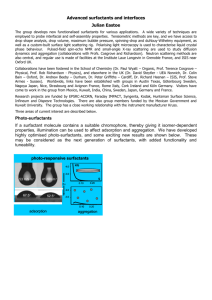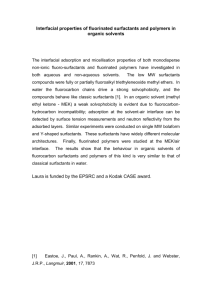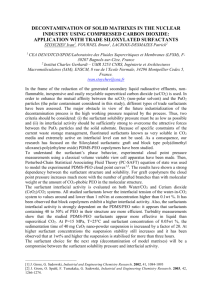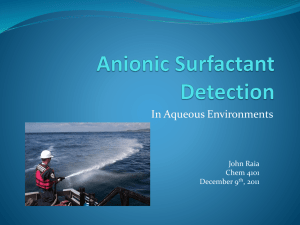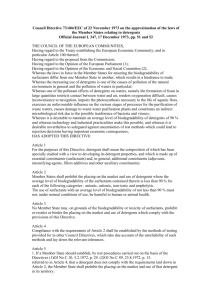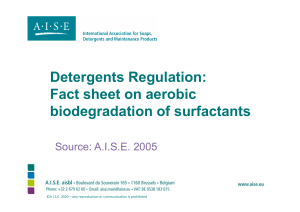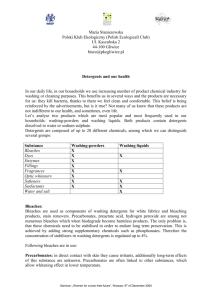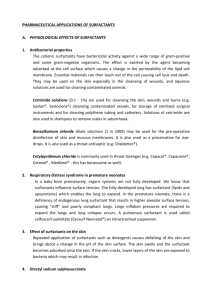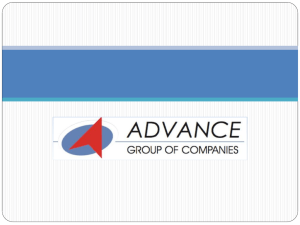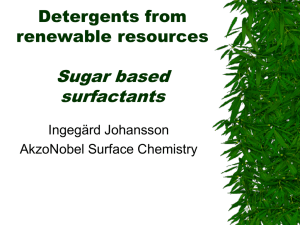DOCX
advertisement
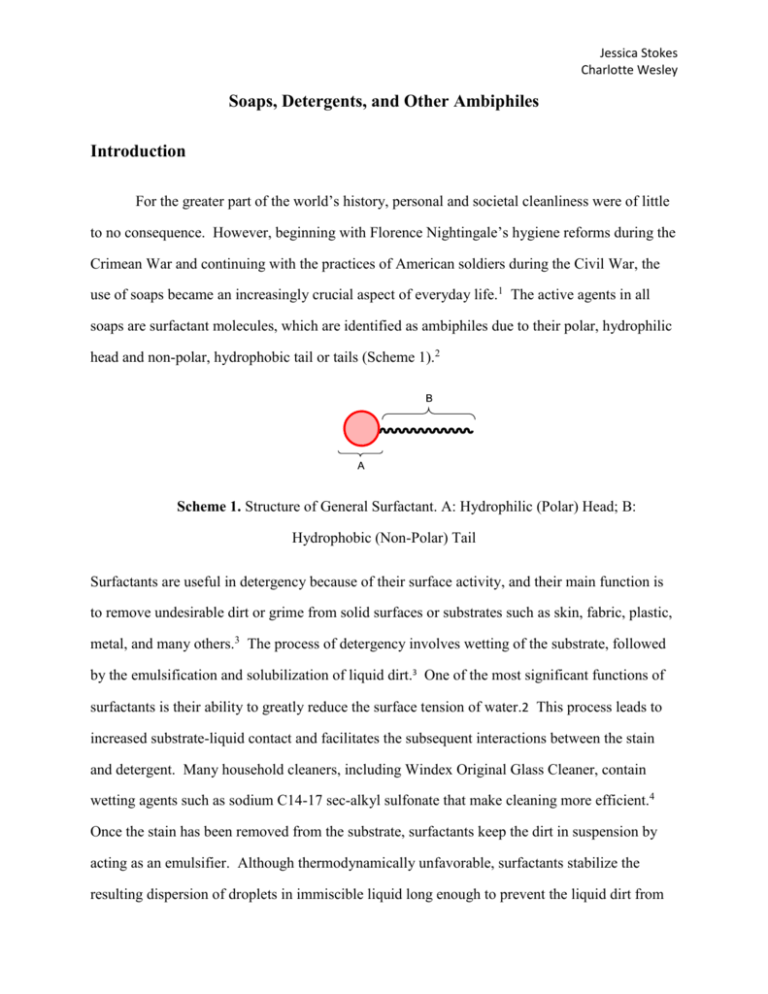
Jessica Stokes Charlotte Wesley Soaps, Detergents, and Other Ambiphiles Introduction For the greater part of the world’s history, personal and societal cleanliness were of little to no consequence. However, beginning with Florence Nightingale’s hygiene reforms during the Crimean War and continuing with the practices of American soldiers during the Civil War, the use of soaps became an increasingly crucial aspect of everyday life.1 The active agents in all soaps are surfactant molecules, which are identified as ambiphiles due to their polar, hydrophilic head and non-polar, hydrophobic tail or tails (Scheme 1).2 Scheme 1. Structure of General Surfactant. A: Hydrophilic (Polar) Head; B: Hydrophobic (Non-Polar) Tail Surfactants are useful in detergency because of their surface activity, and their main function is to remove undesirable dirt or grime from solid surfaces or substrates such as skin, fabric, plastic, metal, and many others.3 The process of detergency involves wetting of the substrate, followed by the emulsification and solubilization of liquid dirt.3 One of the most significant functions of surfactants is their ability to greatly reduce the surface tension of water.2 This process leads to increased substrate-liquid contact and facilitates the subsequent interactions between the stain and detergent. Many household cleaners, including Windex Original Glass Cleaner, contain wetting agents such as sodium C14-17 sec-alkyl sulfonate that make cleaning more efficient.4 Once the stain has been removed from the substrate, surfactants keep the dirt in suspension by acting as an emulsifier. Although thermodynamically unfavorable, surfactants stabilize the resulting dispersion of droplets in immiscible liquid long enough to prevent the liquid dirt from Jessica Stokes Charlotte Wesley readhering to the substrate.3 Finally, surfactants will promote solubilization by associating to form micelles around the immiscible droplets via the interaction with their hydrophobic tails.3 The formation of micelles occurs spontaneously as the tails move to surround the hydrophobic surfaces of the stain and imitate a biological environment (Scheme 2).5 Scheme 2. Wetting, Solubilization, and Emulsification of a Substrate In addition to their critical role in detergency, surfactants can also function as antiseptics, disinfectants, and antibacterials.2 There are many different types of detergents in use. The four main types are anionic, nonionic, cationic, and enzymatic. To the everyday consumer, anionic surfactants are very common. Sodium dodecyl sulfate, also known as sodium lauryl sulfate, is an anionic surfactant which is present in most shampoos, toothpastes, hand soaps, and dishwashing liquids.3 These carry a negative charge, which makes them the most effective surfactants for dirt particles.3 Nonionic is another common surfactant in everyday life. These are also present in cleaners, but with less abundance then the anionic surfactants.3 Nonionics, such as linear polyoxyethylene alcohol, work effectively to produce a steric barrier that prevents the soil from reattaching to the original surface3. Because of this, nonionic surfactants are common in shampoos for cleansing.1 Cationic are a third type of surfactants, which are relatively poor detergents.3 Though these lack 2 Jessica Stokes Charlotte Wesley the cleansing power of the others, they can be added in a later stage to provide substrates with a soft feeling.3 Most consumers use these cationic surfactants on a daily bases. For example, Din-alkyldimethylammonium chloride is used as a fabric softener, while other cationics are used in hair conditioners (Scheme 3).3 Scheme 3. Sodium Dodecyl Sulfate (A), Polyoxyethylene Alcohol (B), and Di-nAlkyldimethylammonium Chloride (C). The final common type is not, alone, a detergent, but is used in combination with one or more of the other detergents forms. These enzymatic detergents contain low quantities of enzymes, which work with the surfactants to clean a substrate.6 Enzymes are proteins that are produced by living cells and catalyze specific biochemical reactions at body temperatures.7 In the case of detergency, the enzyme breaks up the stain on the substrate, allowing the surfactants to work faster. One enzyme alone cannot break up all the types of stains out there. There are four main types of enzymatic detergents, protease, amylase, lipase, and cellulase, which can each carry out different jobs.6 The proteases work to degrade proteins. They cleave the peptide bonds of protein-based stains such as blood and certain foods like eggs.6 Amylases break down starches, while lipase is used to break down fats.6 Cellulases do not work to degrade any particular stain but instead works on the fabric or other surface.6 These enzymes are found in the same products as the anionic and nonionic surfactants, such as household laundry cleaners and dishwashing detergents.6 3 Jessica Stokes Charlotte Wesley Materials and Methods Results Discussion Conclusion References 1 Chemists Clean Up: A History and Exploration of the Craft of Soapmaking. Kostka, K. L.; McKay D. D. J. Chem. Educ. 2002, 79, 1172-1175. 2 Cleaning Up—Soap, Detergent, and More. Judd, C. J. Chem. Educ. 2002, 79, 1179-1181. 3 A Superficial Overview of Detergency. Poce-Fatou, J. A. J. Chem. Educ. 2006, 83, 1147-1151. 4 S. C. Johnson & Son, Inc. 2011. “Windex.” Jan 30, 2012, <http://www.whatsinsidescjohnson.com/en-us/products-by-brand/windex/windex-originalglass-cleaner.aspx>. 5 MD Simulations of Spontaneous Membrane Protein/Detergent Micelle Formation. Bond, P.J.; Cuthbertson, J.M.; Deol, S.S.; Sansom M.S.P. J. Am. Chem. Soc. 2004, 126, 15948-15949. 6 Proteolytic Enzymes in Detergents: Evidence of Their Presence through Activity Measurements Based on Electrophoresis. Saperas, N.; Fonfría-Subirós, E. J. Chem. Educ. 2011, 88, 17021706. 7 Merriam-Webster, Inc., 2012. Encyclopedia Britannica Company, Jan 30, 2010, <http://merriam-webster.com/dictionary>. 4
